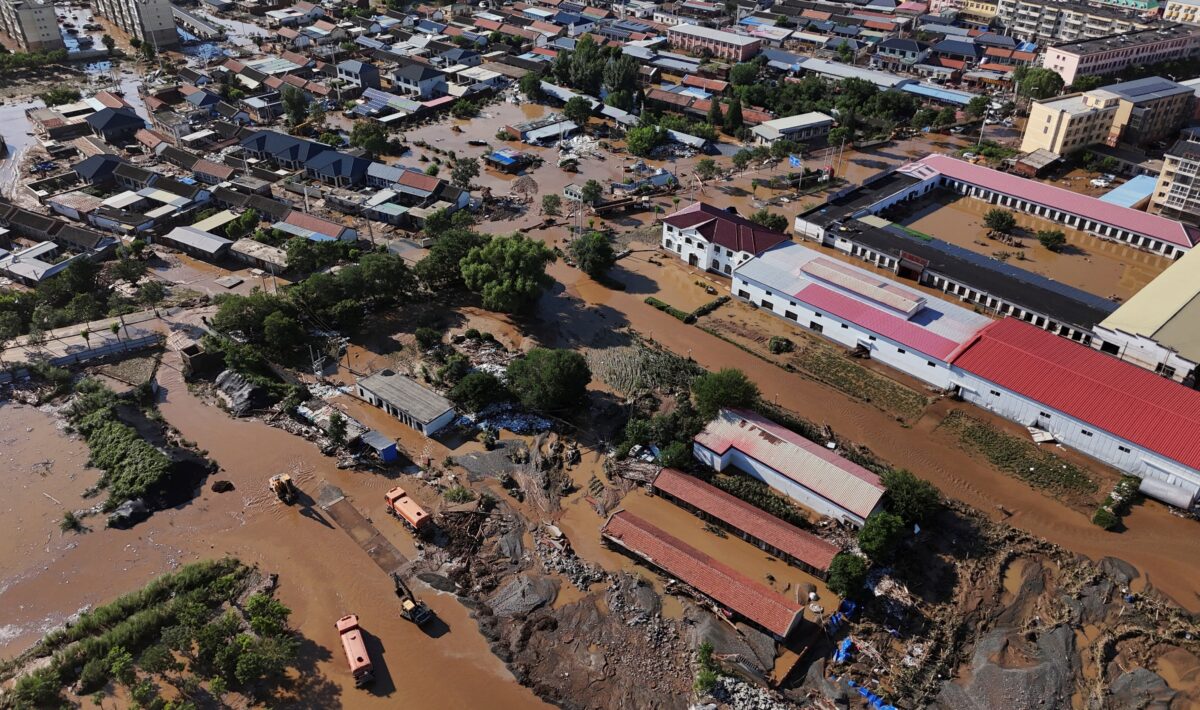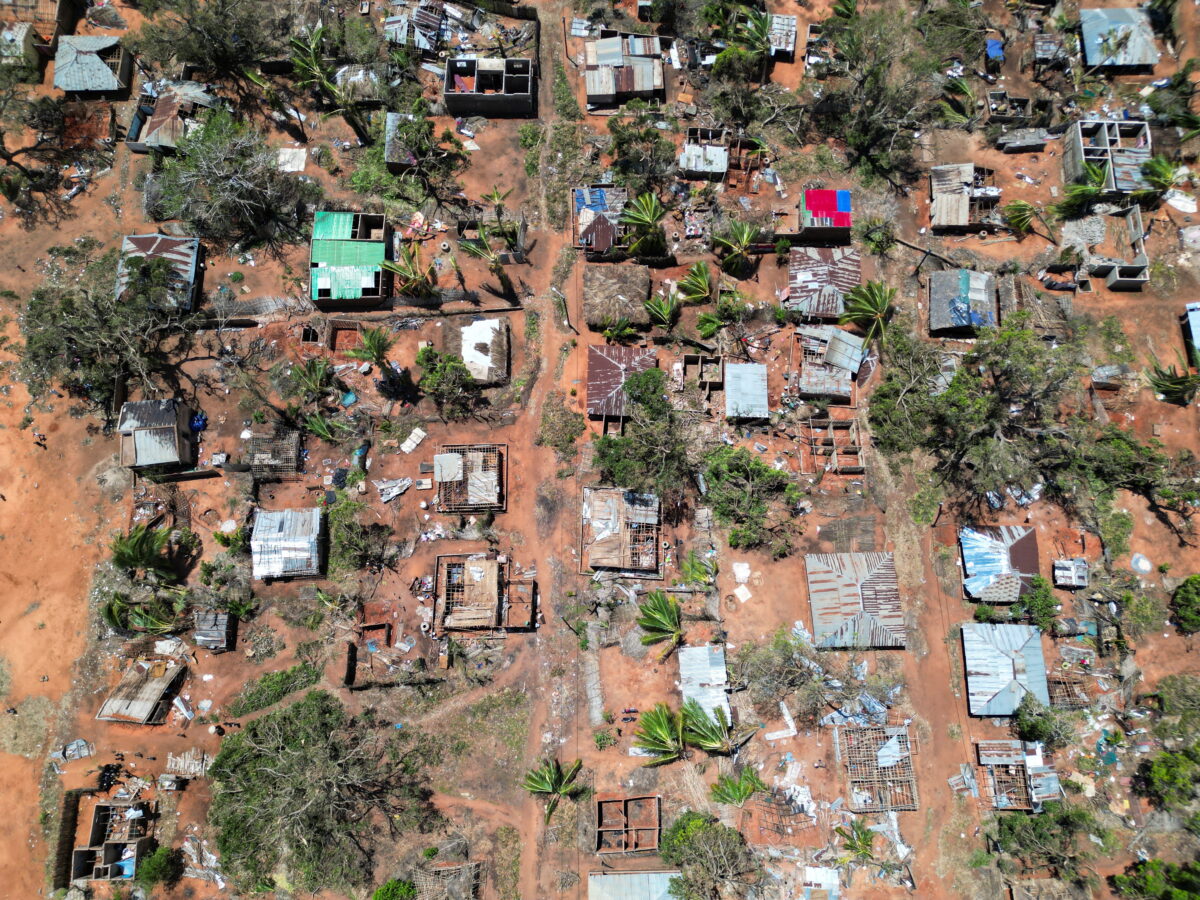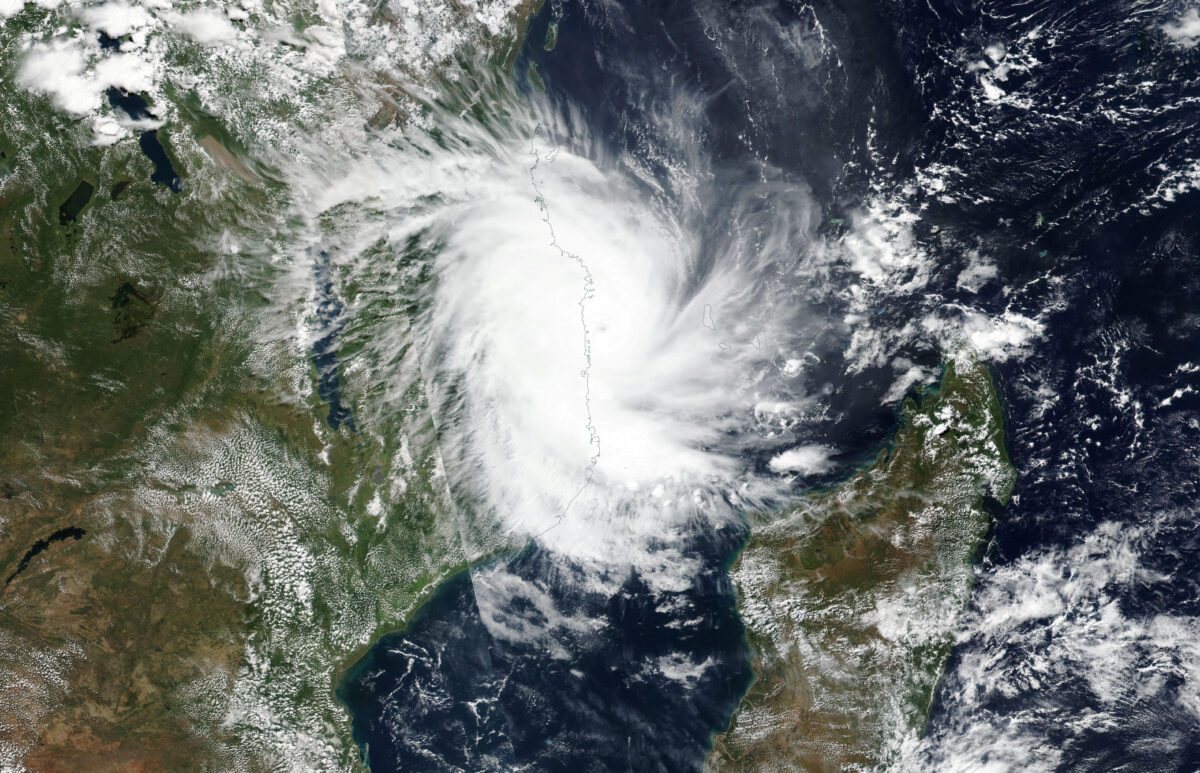A Recent Decrease of Oil Production in Syria? Overview of Open Source Monitoring of Makeshift Oil Sites in Deir Ez-Zor
Monitoring activities at makeshift oil sites in Syria’s Deir Ez-Zor Governorate through satellite imagery suggests there has been a sharp decrease in production activity in the last half of 2016. There could be various reasons for the drop in oil refining, which could have implications for any future strategy of the Islamic State to gain access to other regional natural resources as means of compensation for this loss.
This post was made with the help of Christiaan Triebert @trbtc and Samir @Obretix.
Targeting the Islamic State’s oil sites
As US-led Coalition forces under the umbrella of Operation Inherent Resolve (OIR)and the Russian Air Force (RuAF) stepped up targeting of Syria’s oil industry in Deir Ez-Zor province to diminish the income of the so-called Islamic State (IS), civilians and armed groups have been scrambling for other means to increase the oil revenues. Refining crude oil in artisanal refineries was already common soon after the conflict escalated in 2012, as many trained engineers and staff working in professional oil refineries fled the area, joined armed groups or found another source of income. This decrease in oil production had a severe impact on the oil profits made by armed groups, that had to look for other means of production to keep the money flowing. Crude oil was sold to local civilians, who started their own refineries and sold the end-products, mostly benzine and diesel, to oil smugglers. Therefore, OIR air strikesstarted targeting the means of oil extraction and professional production in 2014 by taking out modular refineries, oil pumping jacks, well heads, oil processing facilities and oil trucks.
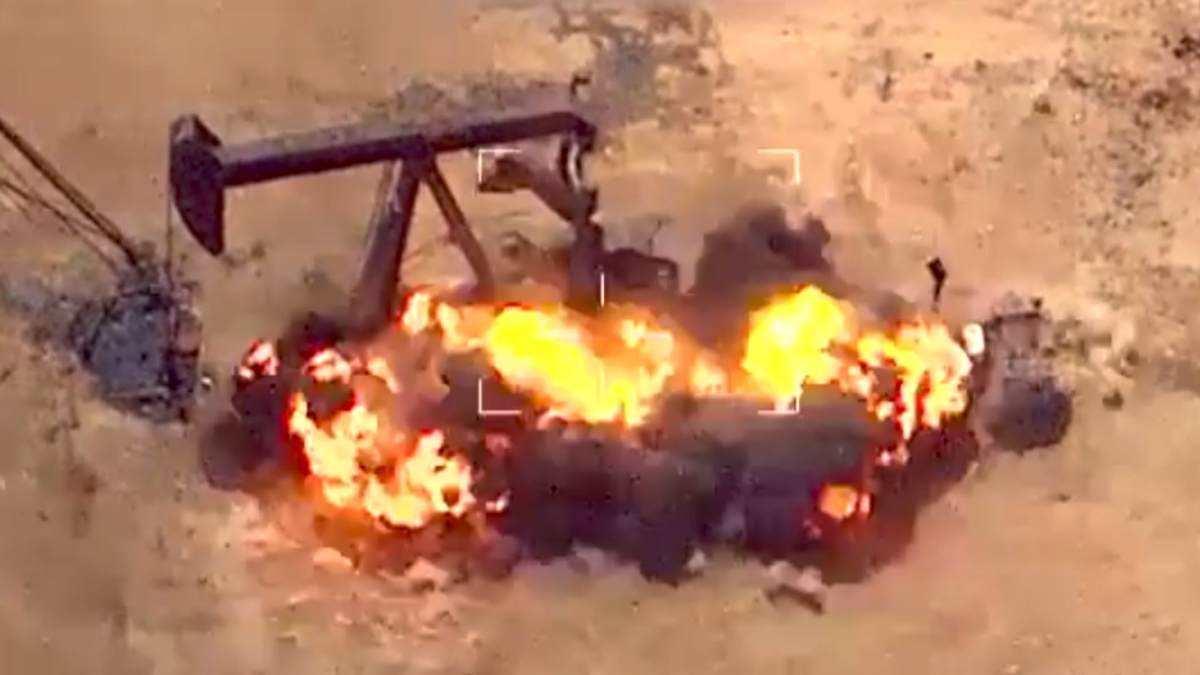
Operation Inherent Resolve strike against pumping jack near Raqqa, May 20 2016
Coalition forces limited their strikes to the secundary oil infrastructure, noting concerns over ‘environmental damage’ if oil wells were hit directly and mostly used precision strikes to stop extraction and production. At the time of writing, the Coalition claims to have taken out 2,638 oil structures. The RuAF had less qualms about the wider environmental concerns and carpet bombed some major oil storage sites and processing facilities in late 2015, early 2016, including attacks on makeshift oil refineries.

RuAF strike against Omar oil station, November 2015
As a result, the Deir ez-Zor governorate witnessed a major increase in makeshift oil refineries, as was documented in PAX’ Scorched Earth and Charred Lives report published in September 2016. Through satellite imagery analysis, obtained from UNOSAT, the report demonstrated the enormous growth at five of the 37 locations in Deir Ez-Zor, counting over 10.000 individual oil refineries at these five sites. Twitter-user @Obretix, whose geolocations have been used in numerous Bellingcat investigations, was responsible for identifying the majority of the 37 locations, and made an interactive overview of these sites, which can be found here:
In all likelihood, more makeshift oil sites have popped up over the last two years that are not yet visible on public satellite imagery.
Human health risks and environmental damage
Most of these makeshift refineries are operated by civilians without having the proper skills or equipment to deal with working in these hazardous working conditions. Therefore, this type of work will most certainly result in many of the workers dealing with acute health risks due to exposure to toxic substances or chronic health problems as they are inhaling noxious fumes day in and out. More worrisome is that often orphan children are employed in this type of work. On the long-term, these practices are likely to result in localised pollution of water sources such as rivers or groundwater, and dumping of hazardous waste by-products from this type of refining, that could lead to further soil pollution.
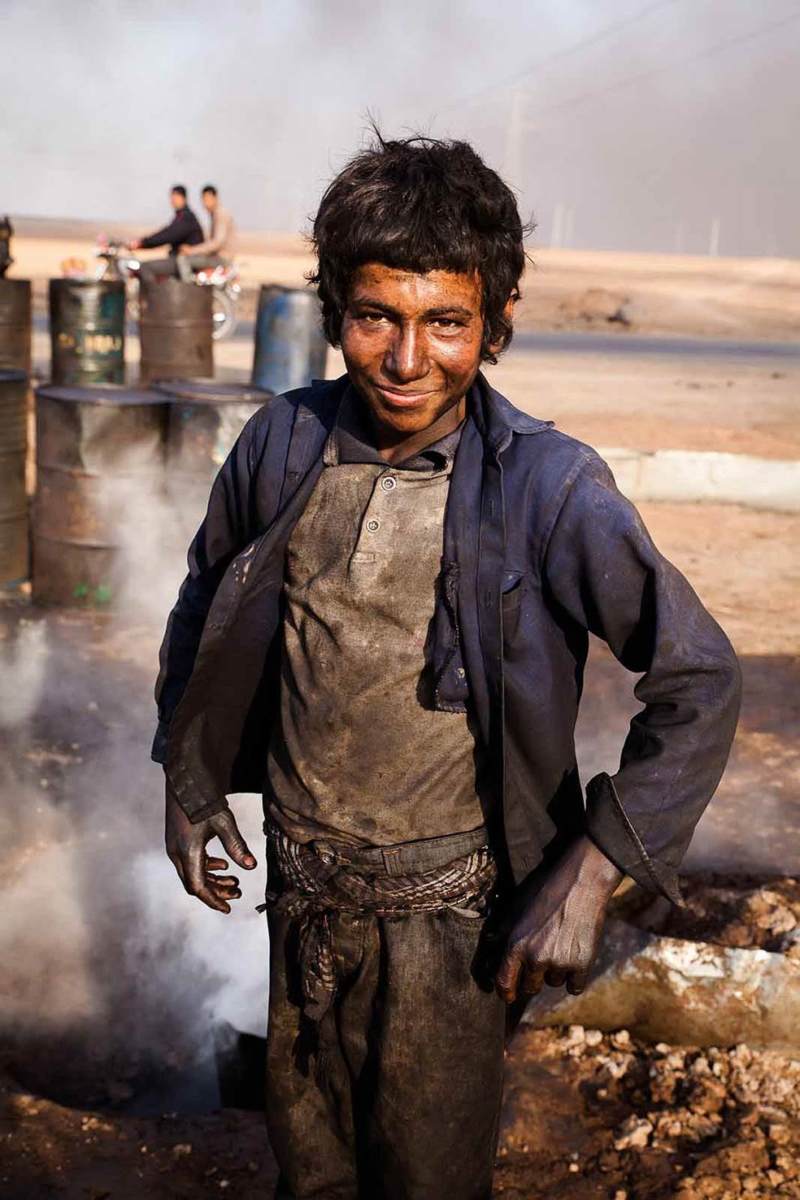
Young boy working at makeshift oil refinery in Hasakah, Syria, 2014. Courtesy of Yann Renout
Monitoring makeshift oil sites
The dark phenomenon that we are witnessing in Deir Ez-Zor is a unique development: tens of thousands of artisanal refineries have sprung up throughout the landscape employing thousands of civilians, exposing themselves to noxious fumes and hazardous substances on a daily basis.
Three issues arise about these make-shift oil refineries. First, it is important timely identify and monitor these locations for quantifying the scale of possible environmental damage, and identifying affected communities that host civilians working there. This should lead to an informed humanitarian response planning that can deal with the most acute consequences, and the information can be part of any post-conflict environmental impact assessment.
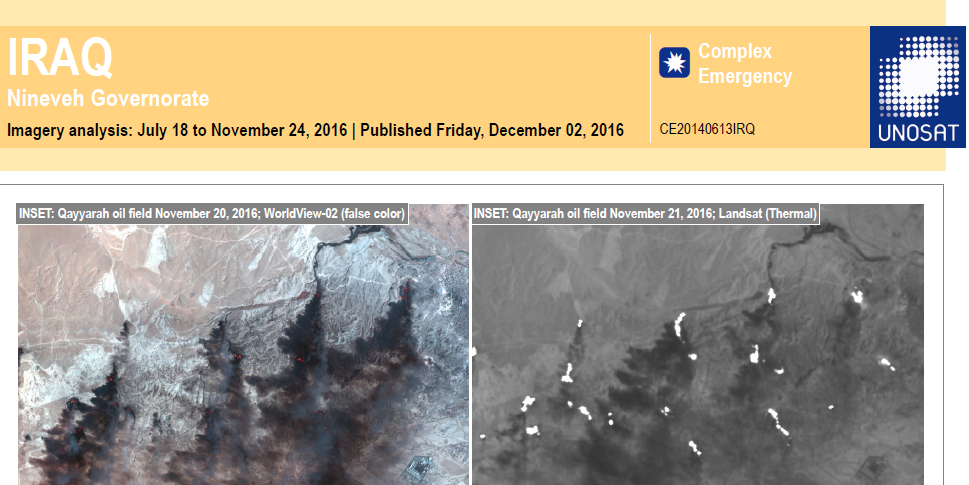
Snapshot of UNOSAT’s Environmental Damage analysis prepared for Humanitarian Respsonse
Secondly, this phenomenon raises questions about the necessity and effectivity of targeting oil infrastructures, as thousands of civilians are forced to refine their own oil to make a living as result of such airstrikes. These targeting procedures could both have direct or long-term health risks, or destroy and potential for post-conflict reconstruction of the country as their economic and industrial assets have been severely damaged or destroyed. Analysing the consequences of such procedures could lead to improved guidelines and if needed, restrictions to be developed for future operations.
Thirdly, lessons learned from Qayyarah in Iraq, where ISIS set fire to dozens of oil wells that are still burning at the moment of writing, does not bode well for Syria. Though most of Syria’s oil fields are located outside populated areas in the desert, setting those on fire could still lead to severe health consequences when the smoke plumes head westwards, causing long-term environmental damage, as well as taking away vital natural resources that were a key source of income to local communities. Monitoring activities around oil wells and key oil infrastructures, and timely responding to indications of attempts to blow them up seems highly needed to prevent another burning oil hell in Syria’s desert
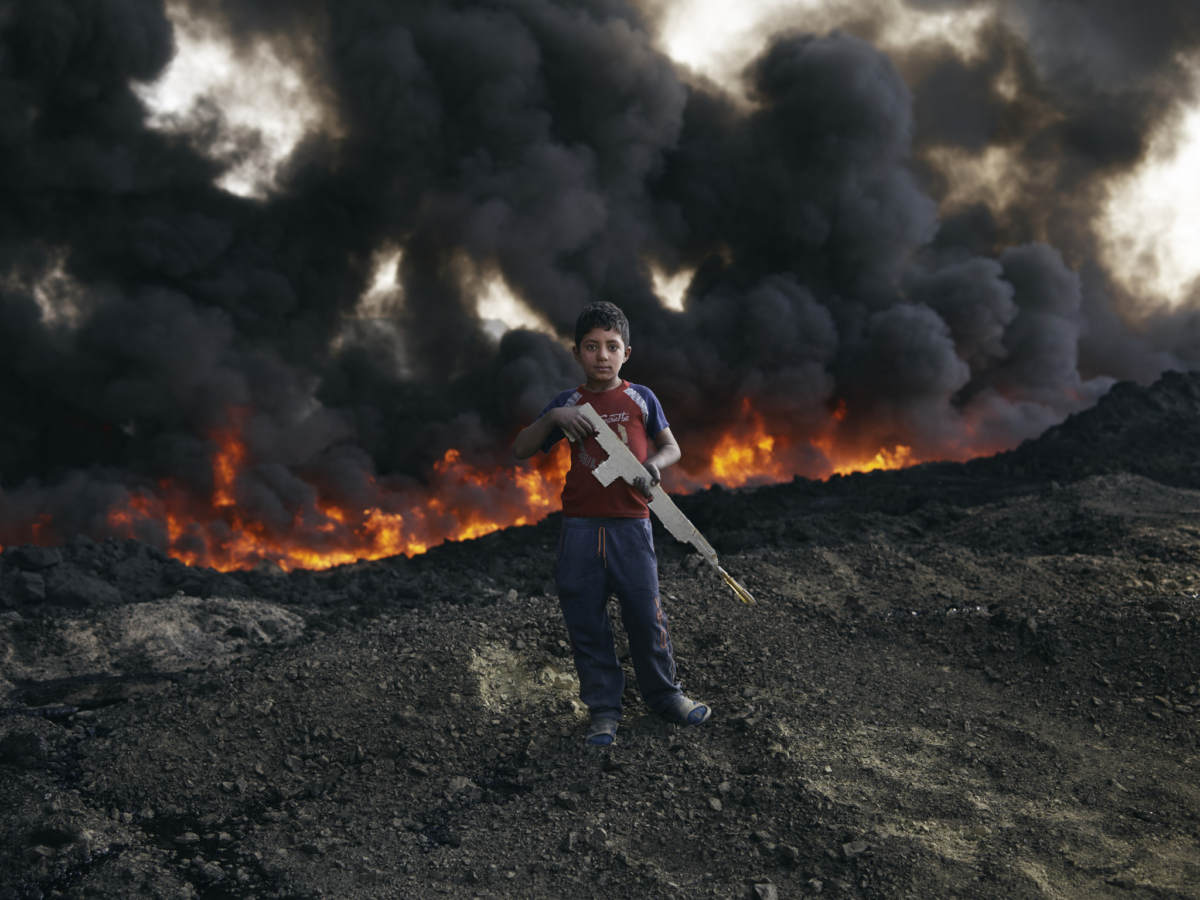
Zaer Ibrahim, 8 plays by the burning oil fields in Qayyarah. Photo by Joe L. for Oxfam International.
Getting the data
The mapping exercise for the Scorched Earth report was limited to five locations, north-west of the city of Deir Ez-Zor. For this article, other locations that have a stronger link with attacks on nearby oil facilities have been examined, which helps understand how crude oil is transported to sites, and check developments at earlier identified sites. These sites are the Omar oil field, the Mayadin makeshift site, and the Tabiyeh gas plant. Identification of activities around these sites can be deducted from the present of burning fires to heat the crude oil, the blackness of the earth around the structures, indicating use from spills, the presence of transportation trucks and other modes of transportation.
The image below is an example of an active makeshift oil structure, identified by the smoke plume and oil sooth around the structure.
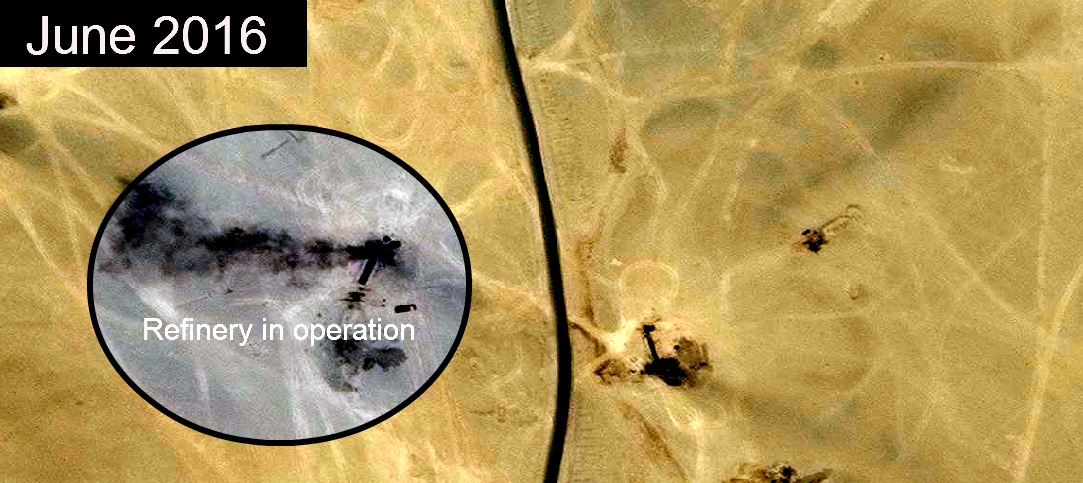
Makeshift oil site in operation at oil site north west of Deir Az Zor, June 2016.
The Omar oil field
In the desert across the Euphrates river, southeast of Deir Ez-Zor city, the Omar oil field is located, which was exploited by the Al Furat Petrol Company in cooperation with Shell before the war. Al-Farut also was responsible for the Tanak, El-Ward and Thayyem oil fields. The Omar gas plant is an important source for providing energy to the Governorate of Homs and (other) local networks. In October 2015, Coalition forces targeted “oil refineries, command and control centres and transportation nodes” at the Omar oil field, and in December that year the RuAF targeted the main facility, including oil storage tanks resulting in severe damage.
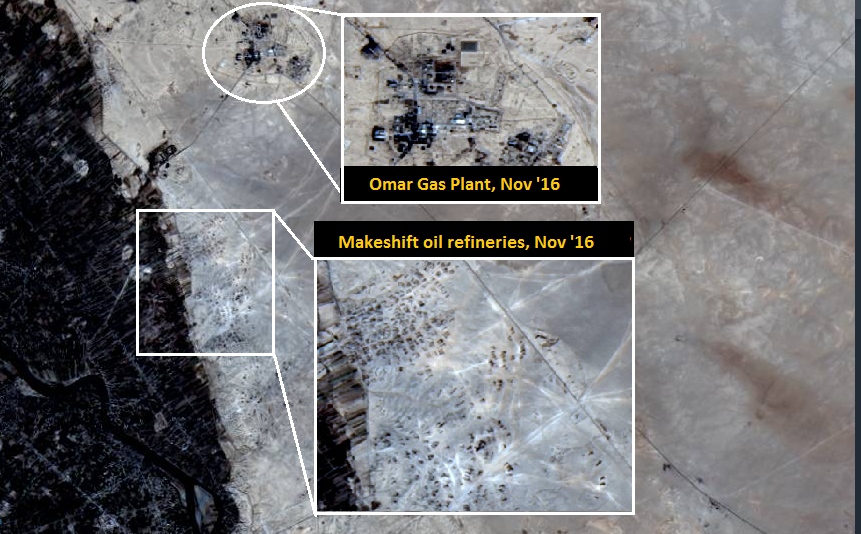
Overview Omar oil refinery and makeshfit oil refineries. Image from LANDSAT 8, NASA, November 6, 2016
As of 2014, satellite imagery indicates a growth of makeshift refineries south-west of the gas plant, whereas the crude oil likely is transported from the oil wells from the Omar, Jarnof and Qahar oil fields east of the gas plant. Comparison of satellite images from May 2016 with November 2016 seems to indicate that use of the makeshift oil refineries has halted, as no smoke, sooth or other production and transportation activities can be seen around these sites.
Omar makeshift #oil sites, November 2016 m pic.twitter.com/xO4aQUUbVz
— Wim Zwijnenburg (@wammezz) December 13, 2016
Based on TerraServer high resolution, and DigitalGlobe preview images from 2016 (Catalogue ID 104001001C26D600), there are likely at least 1,000 makeshift oil structures at this location.
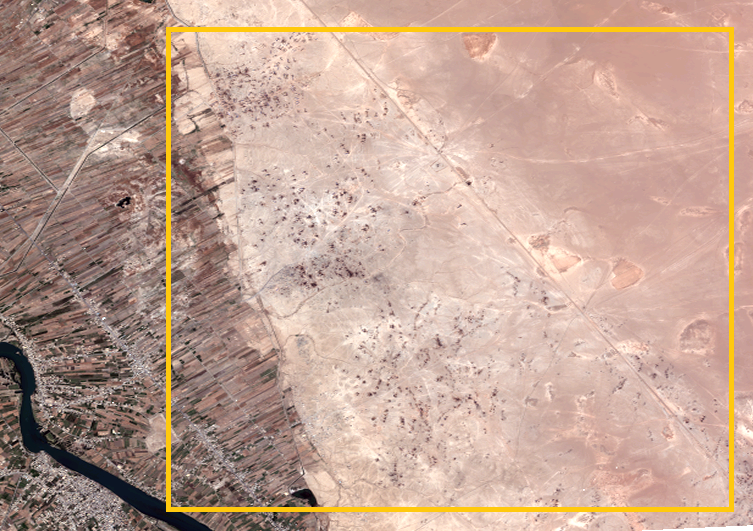
Overview Omar Makeshift oil site. Image by Digital Globe, May 2016
The most recent LANDSAT 8 images of the entire Omar oil field also show sporadic fires around oils wells, which might indicate some wider issues with extracting crude oils from the wells.
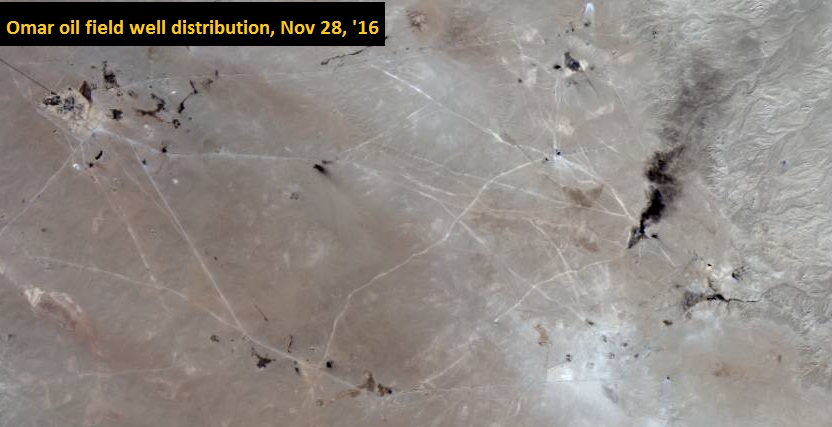
Mayadin makeshift site
South of the Euphrates river and the above mentioned oil fields, another makeshift site was identified on Google Earth. From the north-west of the town of Mayadin, a road heading towards Deir z-Zor city, with at each site of the roads hundreds of makeshift oil structures stretching out both into the desert as well as towards the Euphrates river. Images from Google Earth in 2014 and TerraServer from 2013 demonstrates an increase in makeshift oil structures at this sites, with at its peak likely between 500 to 1,000 structures being built and operated.
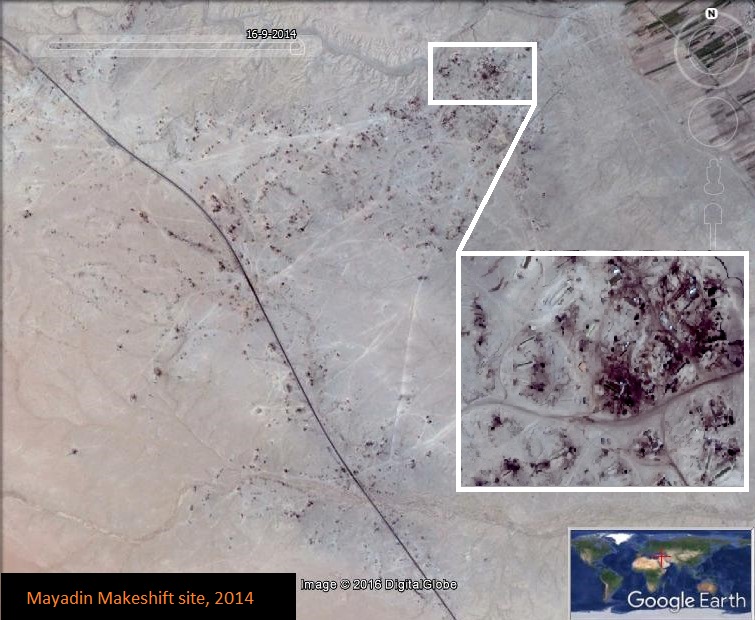
However, images from 2014 and 2016 compared show a decrease of activities, with little to no active oil structures on the latest satellite imagery from November 2016.
Mayadin #oil sites, November 2016 https://t.co/7exQAH8ls0 pic.twitter.com/4hLWrOQq0W
— Wim Zwijnenburg (@wammezz) December 13, 2016
Tabiyeh gas plant
Similar developments can be seen at Tabiyeh oil field, where artisanal oil structures popped up in the last 3 years, but seem to be put out of use in the last couple of months, as demonstrated in the satellite imagery below, showing makeshift structures near an oil well.
Tabiyeh #oil sites, November 2016 pic.twitter.com/f0l5E4dpiF
— Wim Zwijnenburg (@wammezz) December 13, 2016
Here as well, no active structures can be seen, and the images indicated that most of the trenches have been covered with sand, blending into the surrounding landscape
Other locations:
The only sites where there was still intense activity are the sites analysed for the Scorched Earth.. report, which are located north-east of Deir Az-Zor city. Yet even there the imagery is relatively old, dating back from June 2016.
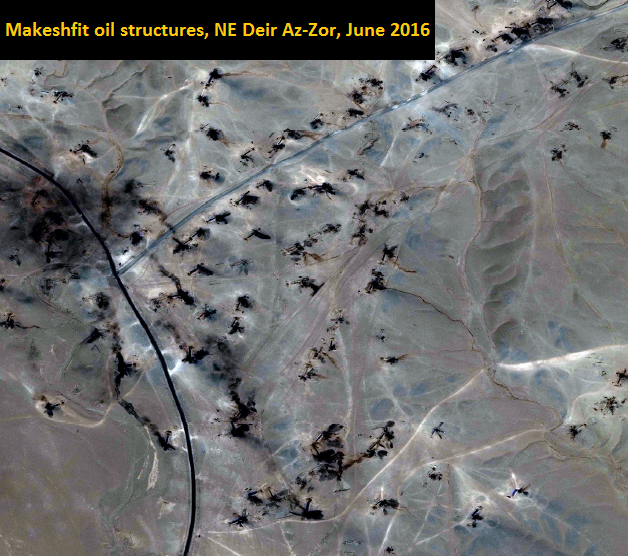
Active makeshift oil structures, June 2016, north east of Deir az Zor. Image by Digital Globe, with courtesy to UNOSAT
Another important oil refinery which was target by OIR was the Jafra oil refinery. Below an image from LANDSAT 8, November 2016, showing the presence of at dozens of makeshift oil refineries. This demonstrates how there was a shift between professional oil refining to artisinal refineries, likely as a result of targeting the profesional oil infrastructure.
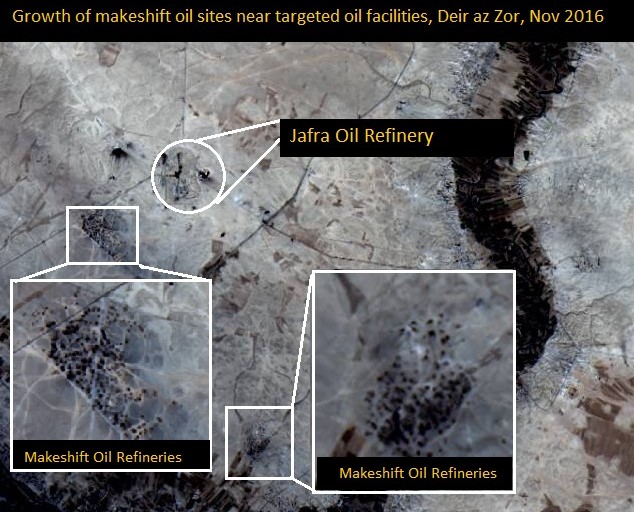
Overview Omar oil field with makeshift refineries. Image from Landsat 8, NASA, Nov 6, 2016
Conclusion
The aim of the Coalition’s Operation Inherent Resolve was to contain IS’ oil production and smuggling to prevent them from making money on oil revenues. Air strikes targeted various oil infrastructure locations around Deir Ez-Zor, thereby aiming to limit crude oil extraction and refining. As result, more civilians started to refine their own oil, with subsequent human health and environmental risks. These makeshift oil sites were documented and monitored over the last six months. Open source investigation of selected oil sites near oil fields where crude oil is extracted from oil wells, and thus could be transported to local makeshift oil sites, demonstrate that has been a sharp decrease of activities at a majority of the selected sites. Local reports coming from Deir Az Zor confirms the analysis of imagery. There could be several explanations for this change. Firstly, the flow of crude oil to these sites have been stopped, thus limiting civilians in their activities. This could be the result of the targeting the well heads and pumping jacks, limiting the crude oil extraction process. Moreover, Coalition forces have stepped up targeting of oil transportation trucks, making it more difficult to get the crude oil from the wells to the makeshift refineries. In the most recent media release early December 2016, OIR claims to have destroyed 168 oil tanker trucks in the Deir Az Zor governorate. The Coalition also targeted several major bridges crossing the Euphrates, hindering transport of oil to (makeshift) refineries south of the river.

Image from footage released by OIR, December 2016.
This might also explain the current move from to take over Palmyra and the nearby Shain, Jihar and Al Mahn gas fields, as well as the Bilas oil field, bearing in mind that they need to keep access to valuable natural resources to provide them with energy resources and/or leverage to the Syrian regime to sell back the gas.
Secondly, the activities could have been paused during the summer due to the high temperatures in the desert and may resume in cooler, winter times. Thirdly, according the earlier mentioned local report, the appetite among civilians at these sites is declining, fearing air strikes, either by Russian or Coalition targeting of various oil infrastructures. Though so far the RuAF is the only attacker that has targeted makeshift oil refineries, according to the footage they released.
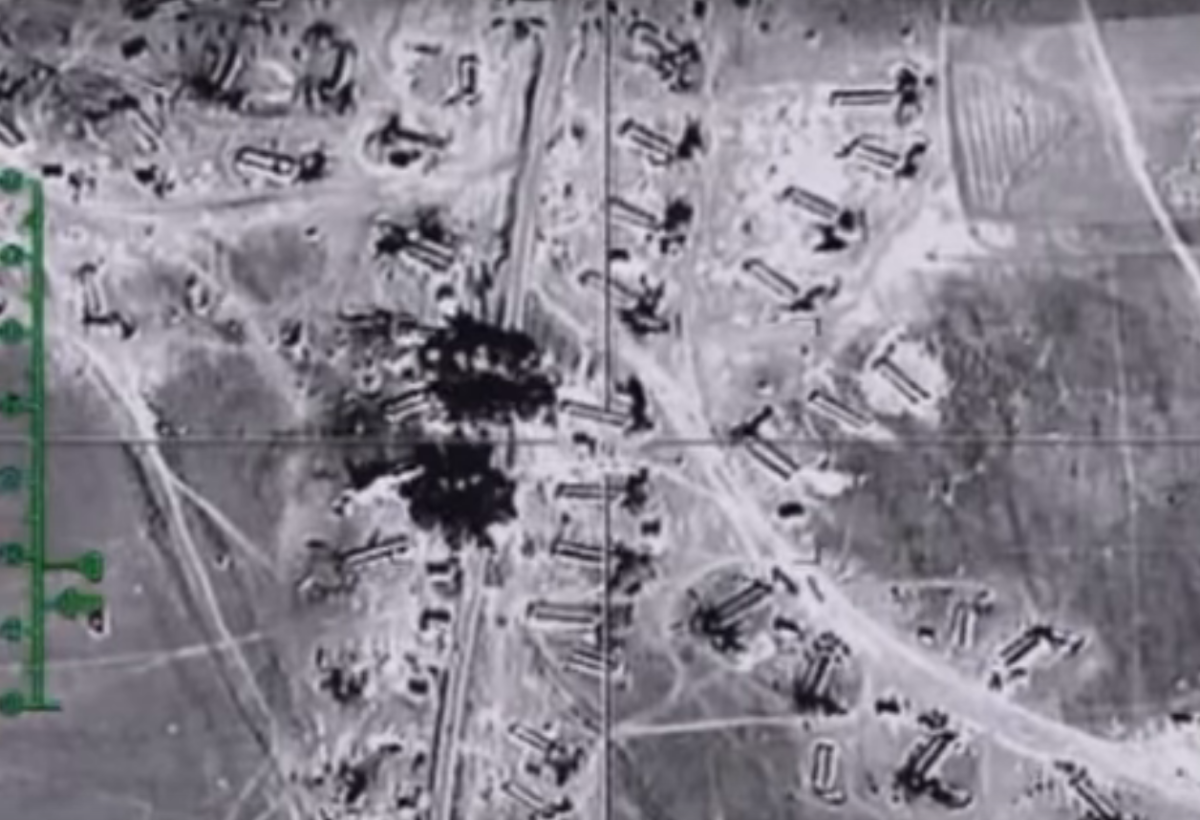
RuAF attacks on makeshift oil structures, February 2016. Footage by Russion Ministry of Defense
A combination of those explanations may also be possible, but whatever the cause is: based on satellite imagery it appears that Syria’s Deir Ez-Zor Governorate has seen a decrease in oil-producing activity over the past months.
